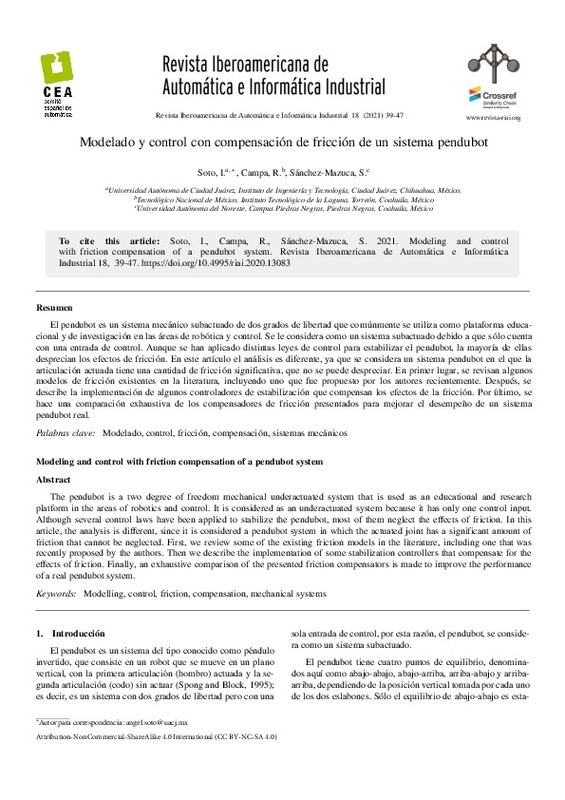Armstrong-Helouvry, B., 1991. Control of Machines with Friction. Kluwer Academic Publishers. https://doi.org/10.1007/978-1-4615-3972-8
Canudas de Wit, C., Olson, H., Astrom, K., Lischinsky, P., 1995. A new model for control of system with friction. IEEE Transactions on Automatic Control 40, 419-425. https://doi.org/10.1109/9.376053
Courtney-Pratt, J., Eisner, E., 1957. The effect of a tangential force on the contact of metallic bodies. Proceedings of the Royal Society A 238, 529-550. https://doi.org/10.1098/rspa.1957.0016
[+]
Armstrong-Helouvry, B., 1991. Control of Machines with Friction. Kluwer Academic Publishers. https://doi.org/10.1007/978-1-4615-3972-8
Canudas de Wit, C., Olson, H., Astrom, K., Lischinsky, P., 1995. A new model for control of system with friction. IEEE Transactions on Automatic Control 40, 419-425. https://doi.org/10.1109/9.376053
Courtney-Pratt, J., Eisner, E., 1957. The effect of a tangential force on the contact of metallic bodies. Proceedings of the Royal Society A 238, 529-550. https://doi.org/10.1098/rspa.1957.0016
Dahl, P., 1968. A solid friction model. Technical report TOR-0158(3107-18)-1, The Aerospace Corporation. https://doi.org/10.21236/ADA041920
Fantoni, I., Lozano, R., Spong, M. W., 2000. Energy based control of the pendubot. IEEE Transactions on Automatic Control 45, 79-86. https://doi.org/10.1109/9.847110
Guemghar, K., 2005. On the use of input-output feedback linearization techniques for the control of nonminimum-phase systems. Ph.D. thesis, Ecole Polytechnique Federale de Lausanne, Lausanne, Switzerland.
Johannes, V. I., Green, M. A., Brockley, C. A., 1973. The role of the rate of application of the tangential force in determining the static friction coefficient. Wear 24, 381-385. https://doi.org/10.1016/0043-1648(73)90166-X
Ma, X. Q., Su, C. Y., 2002. A new fuzzy approach for swing up control of pendubot. In: Proceedings of the American Control Conference. Anchorage, AK, USA.
Morin, A., 1833. New friction experiments carried out at Metz in 1831-1833. Proceedings of the French Royal Academy of Sciences 4, 1-128.
O'Flaherty, R. W., Sanfelice, R. G., Teel, A. R., 2008. Hybrid control strategy for robust global swing-up of the pendubot. In: Proceedings of the American Control Conference. Seattle, WA, USA. https://doi.org/10.1109/ACC.2008.4586692
Rabinowics, E., 1956. Stick and slip. Scientific American 194, 109-118. https://doi.org/10.1038/scientificamerican0256-109
Sanchez-Mazuca, S., Campa, R., 2013. An improvement proposal to the static friction model. Mathematical Problems in Engineering 2013. https://doi.org/10.1155/2013/946526
Sanchez-Mazuca, S., Soto, I., Campa, R., 2015. Modeling and control of a pendubot with static friction. In: Cecarelli, M., Hernandez Martínez, E. E. (Eds.), Multibody Mechatronic Systems: Proceedings of the MUSME Conference held in Huatulco, Mexico, October 21-24, 2014. Springer, pp. 229- 240. https://doi.org/10.1007/978-3-319-09858-6_22
Spong, M. W., Block, D. J., 1995. The pendubot: a mechatronic system for control research and education. In: Proceedings of the IEEE Conference on Decision and Control. New Orleans, LA, USA.
Stribeck, R., 1902. The key qualities of sliding and rolling bearings. (in German) Zeitschrift Des Vereins Deutscher Ingenieure 46, 1342-1348.
Wang, W., Yi, J., Zhao, D., Liu, X., 2004. Adaptive sliding mode controller for an underactuated manipulator. In: Proceedings of the International Conference on Machine Learning and Cybernetics. Shangai, China.
Xin, X., Kaneda, M., Oki, T., 2002. The swing-up control for the pendubot based on energy control approach. In: Proceeding of the IFAC World Congress. Barcelona, Spain. https://doi.org/10.3182/20020721-6-ES-1901.00889
Zhang, M. J., Tarn, T. J., 2002. Hybrid control of the pendubot. IEEE Transactions on Mechatronics 7, 79-86. https://doi.org/10.1109/3516.990890
[-]








